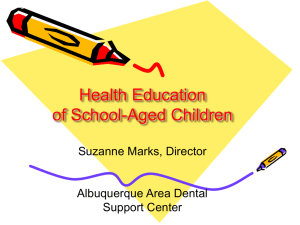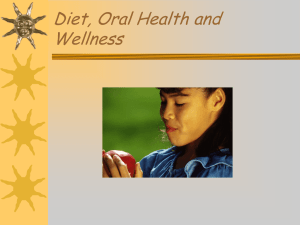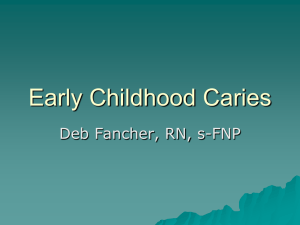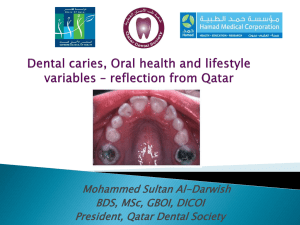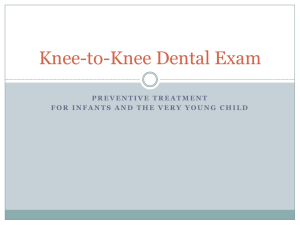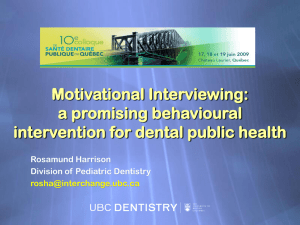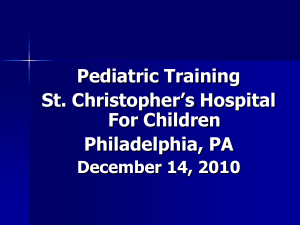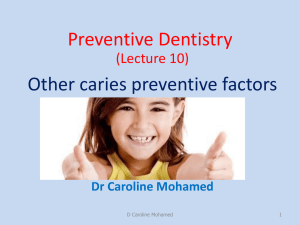Dr.-Erika-Tyler - Superior Health Foundation
advertisement
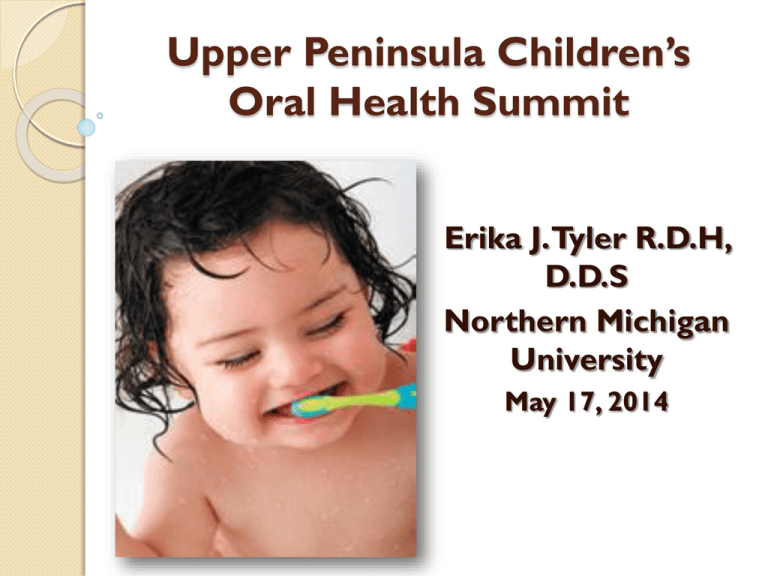
Upper Peninsula Children’s Oral Health Summit Erika J.Tyler R.D.H, D.D.S Northern Michigan University May 17, 2014 Lecture Goals Aren’t they “just baby teeth?” Why should I care? What is a Pediatric Dentist? What is dental decay? What are some prevention ideas? Aren’t they “just baby teeth?” Disease burden Systemic infections Growth problems Low self esteem Quality of life Speech problems Compromised esthetics Pain Economic loss Aren’t they “just baby teeth?” ER visits, Hospitalizations 52 million school hours lost per year for dental problems Public Health Points Oral disease is common and has consequences for overall health Most oral disease is preventable Public Health Points A significant barrier to children’s access to dental care lies in the fact that approximately 90 percent of highest risk kids are enrolled in Medicaid Many dentists have expressed a reluctance to work with kids who are covered by Medicaid Disparities and Oral Health 28% of all preschoolers between the ages of 2 and 5 suffer from tooth decay In HS programs, decay rates range from 30 to 40% of 3-yr-olds and 50 to 60% of 4-yrolds**AAPD Head Start Dental Home Initiative, http://www.aapd.org Disparities and Oral Health Ethnically diverse populations have more oral disease Cultural dimensions of eating, sleeping, childrearing, health behaviors in relation to oral health Disparities and Oral Health Dental caries (tooth decay) most common chronic disease of childhood Dental caries is 5x more common than asthma and 7x more common than hayfever Dental care most common unmet health need* *Vargas et al, 1998; Newacheck et al, 2000a, 2000b, Mouradian, Wehr and Crall, 2000 Disparities and Oral Health Dental insurance: children 2.5X more likely to lack dental coverage than medical coverage* Medicaid: only 1/5 children accessed dental care* 50% of tooth decay in low income children goes untreated *Vargas et al, 1998; Newacheck et al, 2000a, 2000b, Mouradian, Wehr and Crall, 2000 U.S. Dental Workforce Issues Number of dentists per capita declining (~200,000 in 2014) Few pediatric dentists (9300 in 2014) Acute shortages in rural and underserved areas Gaps in Dental Training Most dentists and hygienists are not adequately trained in oral health care of infants and young children, or those with special needs Most medical education has limited dental education Defining the Issue: Michigan ~ 113,000 live births/year (2012) ~900K of Michigan’s 2.5 million kids are Medicaid eligible, (increasing) 58% of Michigan 3rd Graders have caries Decay rates are on the rise in pre-school kids (4% in last 10 years; CDC, 07) Dentistry in Michigan: By the Numbers 115 (2012) pediatric dentists, of which an estimated 84% (~96) see 1 year olds 5140 general dentists, (2012) Evidence suggests that pediatric dentists migrate to upper income communities There are not enough pediatric dentists Most general dentists are not comfortable treating very young children Addressing the Needs of Michigan’s Infants Currently: 113,000 live births =>981 new patients/pediatric dentist/year. If all dentists accepted infants = ~22 infants/year. (If only half see infants = ~ 44 infants/year) Conclusion: This is possible! What is a Pediatric Dentist? Pediatric dentists are the pediatricians of dentistry. A pediatric dentist has two to three years of specialty training following dental school and limits his/her practice to treating children only. What is a Pediatric Dentist? Pediatric dentists are primary and specialty oral care providers for infants and children through adolescence, including those with special health needs Children are not just smaller versions of adults Kid’s teeth and mouths are not just smaller versions of adult teeth and mouths What is a Pediatric Dentist? Kids are not always able to be patient and cooperative during a dental exam Pediatric dentists examine and treat children in ways that make them comfortable Pediatric dentists use specially designed equipment in offices that are arranged and decorated with children’s development in mind Pediatric Dentistry’s Role in Oral Health Anticipatory guidance and counseling Education of parent, child and community Caries risk assessment Oral screening exam Applying fluoride varnish, as needed Appropriate treatment, as needed Establishing a Dental Home Making Oral Health FUN! Pediatric Dentistry’s Role in Oral Health Management of dental emergencies and simple trauma Oral-systemic health interactions, especially for CSHCN, and patients with chronic illnesses Identify and manage developmental and growth issues Dental Decay – Infectious, Transmittable Disease The cariogenic bacteria of primary caregiver can be transferred to child by: ◦ Wetting pacifier with saliva ◦ Pre-chewing the child’s food ◦ Tasting the child’s food ◦ Kissing child on the lips What is Dental Decay??? Biofilm (‘plaque’) is a living community of bacteria Bacteria ferment carbohydrates and produce acid Over time acid demineralizes enamel (white spot lesion) REVERSIBLE! The end result is caries which is non reversible Early Childhood Caries Dental decay in primary teeth, kids < age 6 years old Formerly known as “Baby bottle” tooth decay or Nursing/bottle caries Early Childhood Caries A transmissible infection caused by Streptococcus Mutans Diet dependent – fermentable carbohydrates with frequent exposure Occurs on erupted susceptible teeth Causes cavities to develop over time ECC affected children are at higher risk for decay as adolescents and adults Dental Venn Diagrams Dental Venn Diagrams AAPD Guidelines for Caries Risk Caries risk is greater for children who are poor, rural, or minority or who have limited access to care. Factors for high caries risk include: • dmfs > the child’s age • numerous white spot lesions • high levels of mutans streptococci • low socioeconomic status • high caries rate in siblings/parents • diet high in sugar • and/or presence of dental appliances Food Lesson - Eating Frequency Ongoing Balance No Caries ◦ Protective Factors ◦ Salivary flow ◦ Fluoride Caries ◦ Pathologic Factors ◦ + + Strep Mutans ◦ Fermentable carbohydrates ◦ Reduced salivary flow Early Childhood Caries Maternal Transmission Window of infectivity: 6 – 30 months Transmission is a natural process Don’t suggest mother decrease contact with infant Help mother meet her oral health care needs Suggest other preventive measures Messages for Parents ◦ ◦ ◦ ◦ ◦ Oral health - important to overall health Primary teeth matter Caries can start as soon as teeth erupt Strep Mutans is transmissible Stress importance of caretaker’s oral health ◦ Advise pregnant moms to receive dental care ◦ Avoid frequent intake of carbohydrates Evidence Based Prevention Recommendations Personal: ◦ Brush with fluoridated toothpaste ◦ Limit sipping/snacking ◦ Visit dentist regularly Professional: ◦ Sealants ◦ Fl- varnishes ◦ Fluoride supps ◦ Dietary counseling Sources of Fluoride Systemic ◦ Water fluoridation ◦ Fluoride supplements Topical ◦ Fluoride toothpastes ◦ Gels ◦ Fluoride varnish Fluoride Can Prevent and/or Reverse White Spot Lesions Mechanisms of action: ◦ ◦ ◦ ◦ Reduces enamel solubility Promotes re-mineralization of enamel Anti-bacterial activity in higher concentrations Action is topical, in saliva Fluoride Community water fluoridation should have 0.7-1.2 ppm fluoride to be effective Fluoride supplements should be prescribed if the water supply does not have adequate fluoridation (naturally; lack of public fluoridation; home filters). Fluoride Infants younger than six months do not require fluoride supplements Infants six months and older who are breast-fed may have the greatest need for dietary fluoride supplements U.S. Fluoride Supplement Schedule, 1994 Age >0.6ppm Community Fluoridation Level <0.3ppm 0.3-0.6ppm 0 mos.- 6 mos. 0 6 mos.- 3 yrs. 0.25mg 3 yrs. - 6 yrs. 0.50mg 6 yrs. - 16 yrs. 1.0 mg 0 0 0.25mg 0.50mg 0 0 0 0 ADA, AAP, AAPD Caries Risk Assessment HIGH RISK if by history: ◦ ◦ ◦ ◦ Previous or current caries Siblings or mom with caries No fluoride in water Chronic health condition and/or medication use ◦ SES, cultural factors ◦ CSHCN ◦ Adapted, Bright Futures in Practice, Oral Health, 1996 Age One Dental Visit All children ◦ Dental evaluation – by age 1 Anticipatory guidance earlier Prioritize dental needs: visible disease or high risk for disease Pregnant women, mothers with disease need timely treatment All children need a regular source of dental care (“dental home”) Often accompanied by bleeding Follows contour of gum-line Pre-Cavity Lesions: White Spot Lesions Brown Spots - Advancing decay process Risk Assessment Do this: 1. Apply fluoride varnish. 2. Make referral to dentist. 3. Explain the importance of regular tooth brushing with fluoride toothpaste. 4. Emphasize early decay can be reversed. What is fluoride varnish? Effective in preventing tooth decay in both the primary and permanent dentition Fluoride varnish is a liquid coating that adheres to the dental Enamel forms a depot from which fluoride is slowly released Fluoride varnish was first introduced in Germany in 1964 Over 30 years of clinical studies in Europe report 25- 45% caries reduction What is fluoride varnish? More recent studies in the United States also support these findings Introduced to United States in 1991 FDA approved in the 1990’s as a desensitizing agent – Used “off label” for caries reduction American Dental Association (ADA) endorses the use of fluoride varnish for caries prevention in May 2006 Holm AK. Effect of a fluoride varnish (Duraphat) in preschool children. Community Dent Oral Epidemiol 1979, 7:241-5. 225 Swedish 3-year-olds Semiannual application of fluoride varnish 44% caries reduction after two years Fluoride Varnish Protective coating that is painted on the surfaces of teeth to prevent new cavities from forming and to help stop cavities that have already started Prevents caries on both smooth surface and pit and fissure sites Minimal chance of ingestion Protective effect of the fluoride varnish will continue to work for several months Fluoride Varnish Fluoride varnish is very easy to apply Fluoride varnish adheres to the teeth so potential ingestion of fluoride is low Fluoride varnish has a yellow color to it when it sets up (Vanish Varnish (Omnii) is white) Parent can be involved by assisting in holding the child in the knee-to-knee position Remove plaque and debris with gauze sponge Varnish Application Varnish Application Post Application Instructions Varnish will set on contact with saliva The applied fluoride varnish will leave a yellow film that will remain on teeth (Vanish Varnish is white) Advantages to Fluoride Application Child-friendly flavors, easily tolerated Easily applied in less than three minutes Teeth need not be cleaned first or even dried completely Is safe and very little, if any, ingestion Does not require the use of any dental equipment Brown Spots - Arrested decay process after 3 mos Public Health Advocacy Monitor children’s health in community Mobilize community partnerships Help develop policies/actions at community level Water fluoridation School based programs Problem solving with local dental societies Link families to needed care Caring for our poorest and most vulnerable Children seen early are less costly to care for over time With very young patients, preventing decay is far easier than restoring teeth Children with less complex restorative needs are less likely to require referral to a pediatric dentist Summary Dental decay is a ◦ significant health ◦ problem for children Anticipatory guidance Oral exam by age 1 Primary care providers have key role Fluoride varnish – safe and effective Collaborate with other health care providers to improve oral health and access to care
